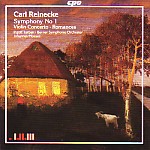Carl Reinecke was a good composer; his basic amiability and mellifluousness has counted against him, but if you take the time to listen you will probably find his elegantly proportioned and melodically distinguished output very enjoyable. So it is with the First Symphony, a very pretty but nonetheless tightly constructed paean to a sunny A major. For reasons that we need not go into, I happen to have the score of this work, and so can speak with some familiarity, particularly regarding its felicitous orchestration. This is extremely conservative (double winds, two trumpets, three trombones, four horns, timpani, and strings), but very effectively deployed. The strings lead, the woodwinds decorate, and the brass is used judiciously but effectively. For example, the trombones first appear in the very beautiful slow movement, but without trumpets (which are featured in the first movement minus trombones). The entire ensemble plays only in the finale, which has plenty of energy that never slackens. There’s nothing earth-shattering here–just good music, often of a balletic quality, and featuring an innocence and simplicity of expression that perhaps explains why the piece has not been deemed worthy of respect (historically) as a representative of the mid-Romantic German symphony.
The Violin Concerto also is very attractive. Its thematic material is primarily lyrical, and the relatively relaxed tempos of its outer movements (Reinecke was big on “moderatos” and “non troppos”) give the soloist sufficient room to spin out some of the more intricate passagework without breaking much of a sweat. It was composed for Joachim, who apparently played it with pleasure until the Brahms concerto came along a few years later, after which time he dropped it like a hot potato. Reinecke was no Brahms, a fact that apparently galled him, but happily this didn’t move him from his chosen path (can you imagine Brahms writing a harp concerto?).
The two romances for violin and orchestra show Reinecke’s melodic gifts at their most winning. Violinst Ingolf Turban has no difficulty with this comparatively untaxing music despite the circumstances of live recording, letting his instrument sing out over the orchestra with an attractively full tone. Both conductor and ensemble sound completely at home in the idiom, and the sonics are consistently good. Whether or not you like this music really depends on your mood. It requires a bit of indulgence if you expect Romantic works in these forms to constitute major statements, but if you’re looking for something comfortably easy on the ear that at the same time never sounds cheap or facile, you will likely enjoy this program.
































